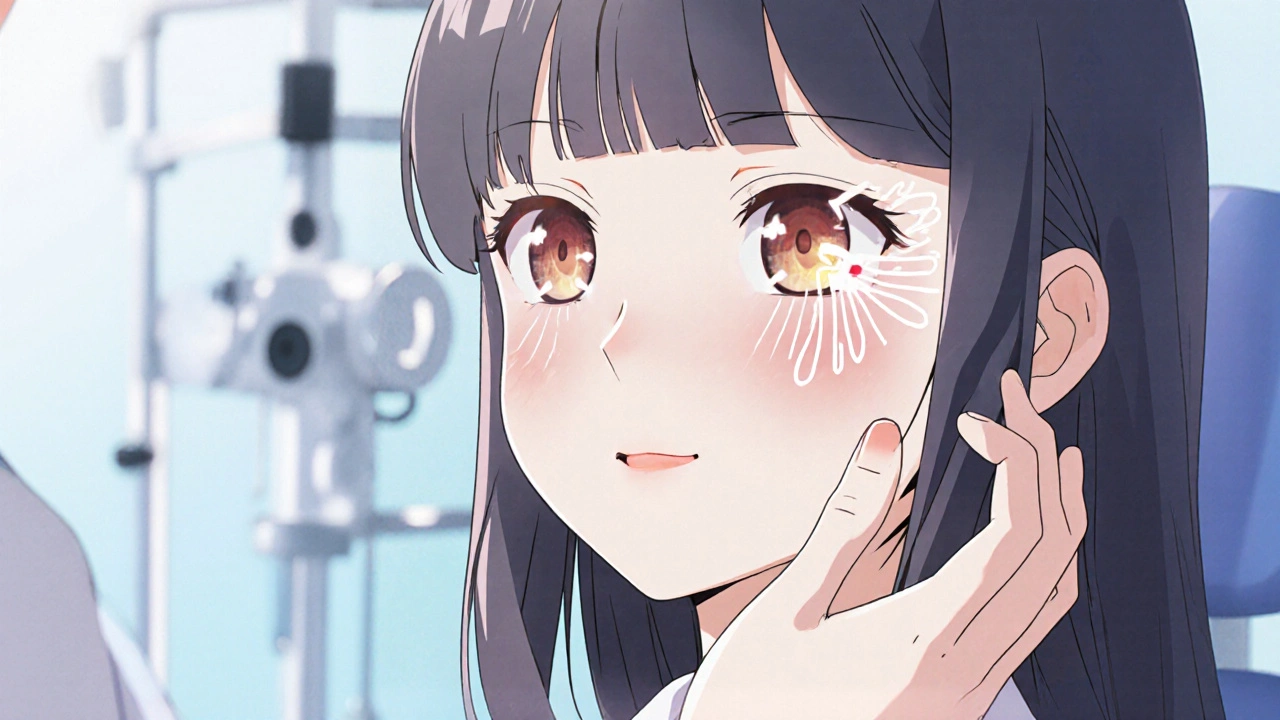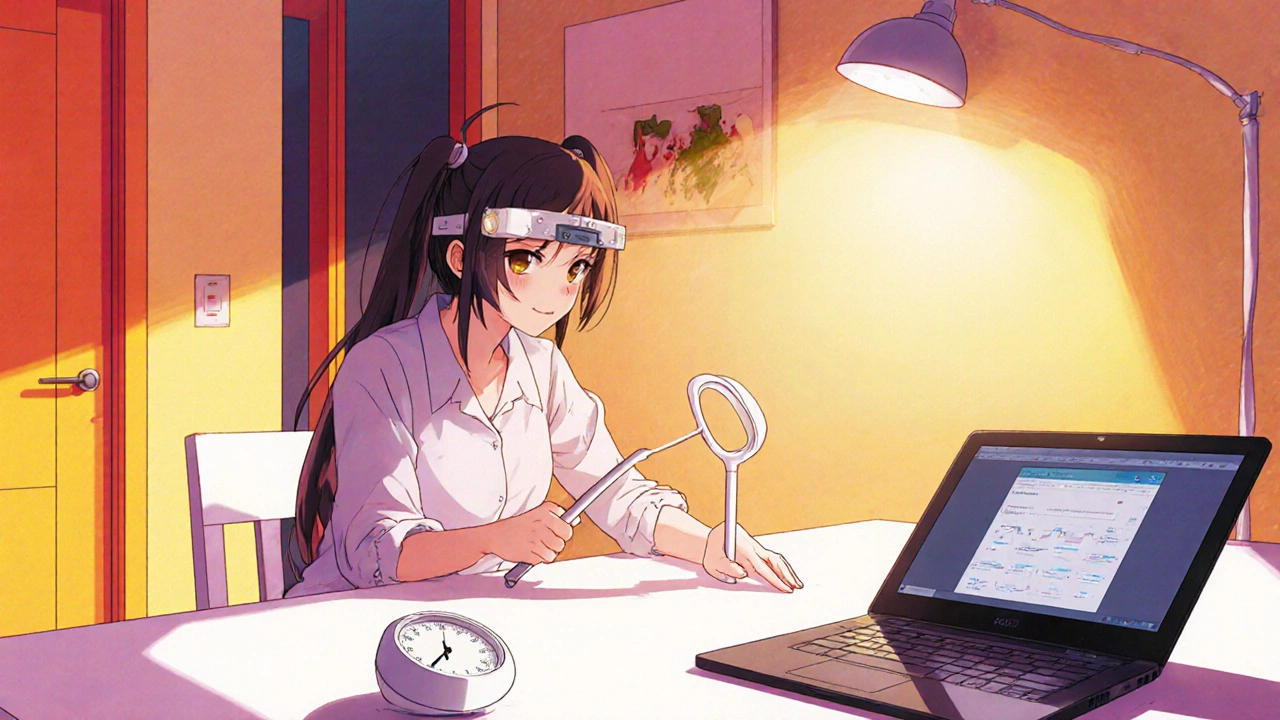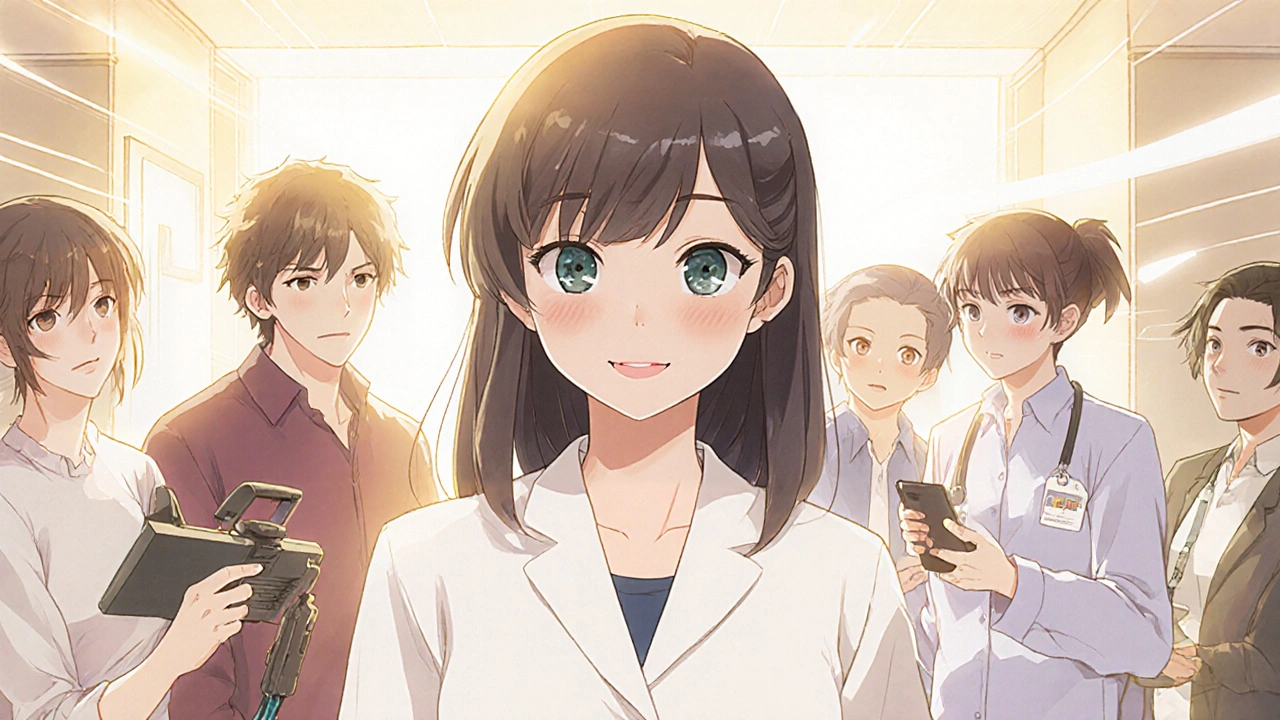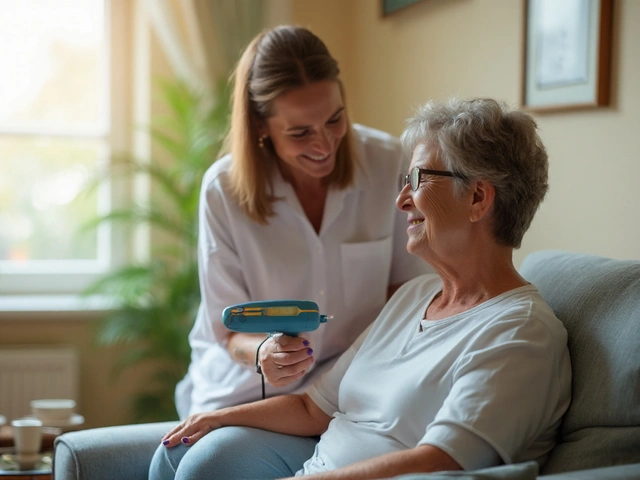
Vision Adaptation Advisor
Personalized Adaptation Recommendations
Answer a few questions about your vision loss to get tailored suggestions for improving your daily life.
When an eye cancer diagnosis lands in your lap, the immediate fear isn’t just about survival-it’s also about what you’ll see (or not see) afterward. Losing sight in one eye, or even part of it, forces you to rethink daily routines, work tasks, and social activities. This guide walks you through what eye cancer is, how treatments affect vision, and-most importantly-real‑world steps you can take to build a new, functional normal.
What Is Eye Cancer?
Eye cancer is a group of malignant tumors that arise from the tissues of the eye or its surrounding structures. The most common types include retinoblastoma in children and uveal melanoma in adults. Ocular oncology teams diagnose these cancers through imaging, biopsy, and genetic testing, then decide on a treatment plan that balances tumor control with visual preservation.
How Treatments Influence Vision
Every treatment carries a trade‑off between eradicating the tumor and keeping the eye functional. Below is a quick comparison of the three most frequently used approaches.
| Procedure | Typical Vision Preservation | Main Side Effects | Recovery Time |
|---|---|---|---|
| Enucleation | None (eye removed) | Pain, cosmetic concerns, need for prosthetic | 2‑3 weeks (surgical healing) |
| External Beam Radiotherapy | Partial; varies by dose | Dry eye, cataract, radiation retinopathy | 4‑6 weeks (treatment + recovery) |
| Laser/Photocoagulation | High if tumor small | Localized scarring, temporary vision blur | 1‑2 weeks (outpatient) |
Choosing a method hinges on tumor size, location, and whether preserving any vision is realistic. Your ocular oncologist will explain the odds of losing sight completely versus retaining enough to perform everyday tasks.
Defining Vision Loss
Vision loss is the partial or total inability to see, ranging from mild blurriness to complete blindness. In the context of eye cancer, loss can be unilateral (one eye) or, rarely, bilateral if both eyes are affected. The degree of loss determines which rehabilitation services you’ll need.
Emotional and Psychological Impact
Seeing is a huge part of how we experience the world; losing that can trigger grief, anxiety, and even depression. Studies from the National Eye Institute show that 30‑40% of patients with unilateral vision loss develop significant emotional distress within the first six months. Early counseling-preferably with a therapist experienced in visual impairment-helps you process these feelings before they become entrenched.

Practical Adaptations for Everyday Life
Even a modest dip in visual acuity changes how you navigate home, work, and the web. Below are concrete adjustments that work for most people adjusting to vision loss.
- Lighting upgrades: Use daylight‑balanced bulbs (5000 K) and add task lighting on reading surfaces. Dimmers let you fine‑tune brightness without glare.
- Contrast enhancements: Paint door frames in a high‑contrast color, use bold‑print labels on pantry items, and switch to dark‑mode settings on phones and computers.
- Mobility aids: A simple white cane can improve depth perception and alert you to obstacles. Some users also benefit from a GPS‑enabled walking stick that vibrates for curb alerts.
- Screen magnifiers: Software like ZoomText or built‑in magnification on smartphones lets you enlarge text up to 20× without loss of clarity.
- Audio cues: Enable voice‑over features on all devices. For the kitchen, a talking thermometer or talking kitchen scale reduces reliance on visual measurements.
These changes take only a few minutes to set up, but they dramatically reduce the risk of accidents and frustration.
Low Vision Rehabilitation
When simple adaptations aren’t enough, a certified low‑vision therapist can tailor a program to your specific visual field. Services often include:
- Prescription of high‑plus glasses or telescopic lenses.
- Training with electronic assistive devices (e‑readers, screen readers).
- Orientation and mobility (O&M) coaching for walking safely outdoors.
- Home‑modification visits to optimize lighting and layout.
Rehabilitation typically starts within three months post‑treatment and can improve functional vision by up to 40%, according to a 2023 study in the Journal of Visual Impairment.
Prosthetic Eyes and Cosmetic Solutions
If enucleation was necessary, a custom‑painted prosthetic eye restores appearance and helps with facial symmetry. While a prosthetic does not restore sight, it reduces self‑consciousness and improves social confidence. Modern prosthetics are lightweight, breathable, and can be refitted as the socket changes over time.

Building a Support Network
Sharing experiences with others who’ve walked a similar path lessens isolation. Consider joining one or more of these groups:
- Eye Cancer Support Forum - an online community moderated by ophthalmic oncologists.
- Vision Impairment Meetup - local gatherings in Auckland that focus on adaptive sports and technology.
- National Federation of the Blind (NZ Chapter) - offers mentoring, legal advice, and advocacy resources.
Additionally, ask your treatment center about peer‑mentor programs; a 2022 survey found that patients with a mentor reported 25% higher satisfaction with their visual rehabilitation process.
Checklist: Steps to Adapt After Eye Cancer
- Schedule a post‑treatment eye exam within 4-6 weeks.
- Ask your doctor about a referral to a low‑vision specialist.
- Set up high‑contrast, glare‑free lighting at home.
- Enable screen magnification and voice‑over on all devices.
- Take a beginner’s orientation‑and‑mobility class.
- Connect with at least one support group within the first month.
- If you had enucleation, arrange a prosthetic fitting appointment.
- Consider psychological counseling to address grief or anxiety.
- Keep a journal of daily challenges and successes; share it with your rehab therapist.
Following this list helps you move from “what happened to me?” to “how I’m living with it.”
Frequently Asked Questions
Can eye cancer be cured without losing any vision?
In early‑stage tumors, especially small retinoblastomas, laser therapy or localized cryotherapy can eradicate the cancer while preserving most vision. However, larger or invasive tumors often require radiation or surgery, which may compromise sight.
What is the typical recovery time after enucleation?
Physical healing of the socket usually takes 2‑3 weeks. Full emotional adjustment and prosthetic fitting can extend to 2‑3 months, depending on individual healing and counseling support.
Are there insurance plans that cover low‑vision devices?
Many public health schemes in New Zealand, such as ACC, provide partial funding for low‑vision aids when a medical prescription is submitted. Private insurers often have similar provisions, but you’ll need to submit a claim with supporting documentation from your ophthalmologist.
How can I stay safe driving after losing vision in one eye?
In New Zealand, you must report any unilateral vision loss to the NZ Transport Agency. Many drivers adapt by using wider mirrors, parking sensors, and avoiding night driving until confidence returns. Some opt for a restricted license that limits driving to daytime and daylight hours.
Is genetic testing recommended for family members?
If the tumor is a retinoblastoma or shows hereditary markers (RB1 gene mutation), genetic counseling is advised. Early testing can identify at‑risk relatives, allowing for routine eye exams that catch cancers before they progress.





Comments (7)
Liberty Moneybomb
They don’t tell you that the real cure is hidden behind a secret cabal of ophthalmic elites.
Alex Lineses
Alex here – let’s break down the multidisciplinary approach you’ll encounter after treatment.
First, a low‑vision rehabilitation specialist will calibrate your visual acuity using adaptive optics and contrast‑enhancement protocols.
Then, you’ll integrate assistive technology such as screen magnifiers, voice‑over APIs, and ocular prosthetics into a cohesive functional workflow.
Don’t forget to request a formal referral for occupational therapy; the jargon might sound heavy but it streamlines insurance approval.
Finally, stay proactive with periodic retinal imaging to monitor for radiation retinopathy – early detection is the key to preserving remaining sight.
Brian Van Horne
Brian reporting: The guide covers essential lighting upgrades and mobility aids with commendable clarity.
Implementing high‑contrast labels and a white cane can substantially reduce hazard risk in daily routines.
Karla Johnson
Karla speaking – the psychological cascade that follows a unilateral eye cancer diagnosis can be as destabilizing as the physical loss itself; grief, anxiety, and a lingering sense of betrayal often surface within weeks.
First, acknowledge that the brain’s neuro‑plasticity can compensate for the missing visual field, but only if you feed it consistent, structured stimuli.
Second, redesign your living space with a systematic hierarchy: start by installing daylight‑balanced bulbs at a 5,000 K color temperature, then add dimmable task lights over reading nooks to eliminate glare.
Third, employ high‑contrast visual cues – paint door frames in matte black, label pantry items with bold sans‑serif fonts, and switch every device to dark‑mode to preserve retinal stamina.
Fourth, integrate a mobility cane or GPS‑enabled walking stick; the tactile feedback reinforces depth perception and alerts you to obstacles before they become accidents.
Fifth, leverage technology: screen‑magnification software like ZoomText can enlarge text up to 20× without raster distortion, while voice‑over features transform visual menus into auditory cues.
Sixth, consider auditory kitchen gadgets – a talking thermometer, scale, and timer eliminate the need to stare at tiny displays while cooking.
Seventh, schedule a low‑vision rehabilitation appointment within three months post‑treatment; certified therapists can prescribe high‑plus glasses, telescopic lenses, and personalized training modules.
Eighth, engage in orientation‑and‑mobility (O&M) coaching to rebuild confidence in outdoor navigation, especially under variable lighting conditions.
Ninth, join peer‑support forums; sharing lived experiences with fellow survivors normalizes the emotional turbulence and provides practical hacks you won’t find in textbooks.
Tenth, if enucleation was necessary, pursue a custom‑painted prosthetic eye to restore facial symmetry and mitigate social self‑consciousness.
Eleventh, prioritize mental health by accessing a therapist familiar with visual impairment, because untreated grief can evolve into chronic depression.
Twelfth, maintain a daily journal documenting challenges and triumphs; this reflective practice supplies data for your rehab therapist to fine‑tune interventions.
Thirteenth, keep your vehicle registration updated with the NZ Transport Agency and explore adaptive driving aids like wide‑angle mirrors and parking sensors before hitting the road again.
Fourteenth, investigate insurance coverage for low‑vision devices; many public schemes such as ACC in New Zealand reimburse a portion of the cost when backed by a medical prescription.
Fifteenth, remember that adaptation is a marathon, not a sprint – celebrate each incremental gain, and you’ll transition from “what happened to me?” to “how I’m thriving.”
Mike Hamilton
Mike here – I totally agree that adaptation is a marathon, not a sprint; the journey tests both mind and body.
One simple philosophy is to treat each small win as a stepping stone toward bigger independence.
Teh community you build around you can become a powerful catalyst for change.
Remember, it’s okay to ask for help, and every assistive tool is a bridge to a richer life.
Ayla Stewart
Ayla: I appreciate the thorough checklist; the emphasis on high‑contrast lighting and voice‑over features resonates with many of us who prefer low‑key adjustments.
It’s important to respect personal boundaries while sharing resources, so I’ll point newcomers to the NZ Vision Impairment Meetup for in‑person support.
Poornima Ganesan
Poornima – while your suggestions are practical, they barely scratch the surface of what a true low‑vision survivor needs to thrive.
For instance, you omitted any mention of occupational therapy, which is vital for relearning daily tasks.
Also, the checklist lacks guidance on navigating digital accessibility laws, a glaring oversight for anyone pursuing employment.
Consider expanding your advice beyond basic lighting tweaks.